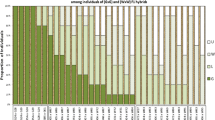Summary
-
1.
Black spot was produced in the laboratory in a reversible reaction by manipulating cell turgor.
-
2.
The amount of air used in cooling potatoes affected black spot.
-
3.
The addition of moisture to the ventilating air used in cooling potatoes lowered the incidence of black spot.
-
4.
Skin characteristics such as lenticel and periderm structure indicate an explanation for varietal susceptibility.
-
5.
The evidence presented in this paper indicates that tuber firmness is a physical factor important to the chemical reaction which gives black spot.
Similar content being viewed by others
Literature Cited
Botjes, J. O. and W. B. L. Verhoeven. 1927. Het blauw worden van aardappelen. (The blue discoloration of potatoes). Tijdschrift over Plantenziekten 33: 57–96.
Boyd, A. E. W. 1951. Internal blackening of potatoes caused by bruising. J. Hort. Sci. 26: 148–156.
Bruyn, H. L. G. de. 1929. Het blauw worden van aardappelen. Tijdchrift over Plantenziekten 35: 182–220.
Collin, G. H. 1958. Factors influencing black spot susceptibility of potatoes. Master’s Thesis, Cornell Univ., Ithaca, N. Y.
Cotter, D. J. 1956. Some observations on black spot of potatoes. Ph.D. Thesis, Cornell Univ., Ithaca, N. Y.
Home, A. S. 1912. Bruise in potato. J. Roy. Hort. Soc. 38: 40–50.
Jacob, W. C. In Press. Studies of internal black spot of potatoes. Mem, Cornell Univ., Ithaca, N. Y.
Massey, P. H. 1952. Field and storage experiments on internal black spot. Ph.D. Thesis, Cornell Univ., Ithaca, N. Y.
Mulder, E. G. 1956. Effect of mineral nutrition of potato plants on the biochemistry and physiology of the tuber. Neth. J. Agr. Sci. 4: (4)333–356.
Oswald, J. W., O. A. Lorenz, F. H. Takatori, Marvin Snyder, Harwood Hall and Herman Timm. 1958. Potato fertilization and black spot in Santa Maria Valley. Cal. Agr. June, 1958.
Sawyer, R. L. 1959. Chapter 6. Potato Processing by Smith and Talburt. Avi Publishing Company, New York, N. Y.
Scudder, W. T. 1951. Black spot of potatoes. Ph.D. Thesis, Cornell Univ., Ithaca, N. Y. 253 p.
van de Waal, G. A. 1929. Het blauw worden der aardappelen. Tidjschrift over Plantenziekten. 35: 60–80.
Verhoeven, W. E. L. 1929. Het “blauw” worden by verschillende aardappelsoorten. Tijdschrift over Plentenziekten. 35: 3–4.
Wiant, J. 1945. Internal black spot of Long Island potato tubers. Am. Potato J. 22: 6–11.
Additional information
Paper No. 427, Department of Vegetable Crops, Cornell University, Ithaca, N. Y., Long Island Vegetable Research Farm, Cornell University, Riverhead, N. Y.
Rights and permissions
About this article
Cite this article
Sawyer, R.L., Collin, G.H. Black spot of potatoes. American Potato Journal 37, 115–126 (1960). https://doi.org/10.1007/BF02855949
Received:
Issue Date:
DOI: https://doi.org/10.1007/BF02855949




